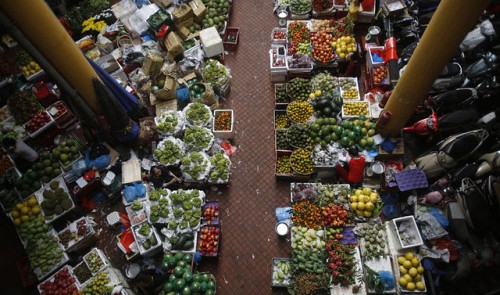The National Financial Supervisory Commission (NFSC), the economic advisor to the Vietnamese government, has prepared a report to review the country’s economy in 2015, which has witnessed many positive improvements in the face of challenges.
Achievements
Vietnam’s economy has obviously improved in 2015, with a GDP growth rate of 6.68 percent, exceeding the official target of 6.2 percent, according to the report.
The industrial production index, which indicates the real output of the country’s manufacturing, increased 9.8-10 percent from a year earlier, while the number of newly-established companies also rose 26.6 percent against 2014.
The total registered capital of the new businesses in 2015 was also 39.1 percent higher than last year, the report said without giving details.
Total retail sales of consumer goods surged about 10.6-10.8 percent, the fastest pace in five years.
This year Vietnam has managed to stabilize the macro-economy and control inflation at a low level, according to the NFSC.
Vietnam’s inflation was kept at 0.6 percent, the lowest since 2001.
The Southeast Asian country’s Incremental Capital-Output Ratio (ICOR) also dropped to 4.62 in 2015, compared to the 5.2 recorded in 2014, 5.6 in 2013 and 6.4 in 2008-12.
ICOR is the ratio of investment to growth which is equal to one divided by the marginal product of capital. The higher the ICOR is, the lower the productivity of capital or the marginal efficiency of capital.
The banking system restructuring plan also resulted in stable liquidity, healthy credit growth and fewer short-term loans.
While short-term lending accounted for as much as over 50 percent of the total outstanding loans in 2011-13, the proportion narrowed to 45.1 percent at the end of the third quarter of this year, according to the NFSC.
Credit growth in 2015 topped 18 percent, much higher than the 14.2 percent a year earlier.
The year 2015 has also seen Vietnam improve its rankings in the World Economic Forum’s competitiveness index for the second year in a row. While the Southeast Asian country stood at the 75th place in the 2013 report, the respective rankings in 2014 and 2015 were 70thand 68th.
In the “Doing Business 2016: Measuring Regulatory Quality and Efficiency” report released by the World Bank in October, Vietnam also jumped three notches to the 90th place, after going from 99th to 93rd in the previous rankings.
According to the NFSC, these improvements are attributable to the implementation of the new law on enterprises and the amended law on investment, as well as solutions set out in the government’s Resolution No.19.
The resolution, issued in March 2015, shows the government’s aspiration to improve Vietnam’s business environment to match regional leaders in 2015-16.
In 2015, Vietnam also signed four significant trade pacts, which all help expand the country’s export markets.
The deals include the Trans-Pacific Partnership (TPP) agreement with the U.S. and ten other nations in the Pacific Rim, the free trade agreement with the Russia-led Eurasian Economic Union, and the trade accords with the Europe Union and South Korea.
The trade pact between Vietnam and South Korea came into effect on December 20, whereas both the trade deals with the EEU and EU are scheduled for implementation in 2018.
The TPP, meanwhile, is pending ratification by 12 member nations before entering into force. The process is expected to begin in Vietnam in mid-2016.
And challenges
Even though the economic picture of Vietnam in 2015 has been quite bright, the NFSC noted that there are still many difficulties, especially in regard to the state budget.
This year proved tough for small businesses, particularly those with a registered capital smaller than VND10 billion (US$446,429), as firms in this category topped the list to go bankrupt, cease operations or be dissolved in 2015, according to the report.
In the meantime, domestic firms were outplayed by foreign counterparts, with the former experiencing a 2.6 percent drop in export turnover and the latter enjoying an 11.5 percent surge.
Vietnam’s state revenue was severely hurt by the collapse of oil prices, as the budget collection fell 34 percent short of its target.
The government suffered a budget deficit equal to five percent of its GDP, whereas public debts are forecast to make up 61.3 percent of the gross domestic product in 2015. Vietnam caps its sovereign debt at 65 percent of GDP.
























































